By Jeffrey A. Rendall, Photos By Jeffrey A. Rendall and Kevin Gaydosh
RICHMOND, VA -- Perspiration versus inspiration. Armchair philosophers argue that in order to achieve success in this world, in virtually any given endeavor, you'll need high percentages of the former with a trifling amount of the latter. But when it comes to golf course design, we won't set a percentage in either direction -- because there's no doubting it takes a healthy dose of both.
And for those who add the extra quality of enthusiasm, they can't help but thrive.
Such is the case for golf architect Lester George. George, based in Richmond, Virginia, has certainly made a reputation for himself of late in the Mid-Atlantic region, placing his signature on one of the country's highest rated new courses, Kinloch Golf Club (in Manakin-Sabot, just west of Richmond. Kinloch was named 'Best New Private Course' for 2001 by Golf Digest, and was also tabbed #10 in the 2003 version of Golfweek's '100 Best Modern Courses').
1972 US Amateur Champion Marvin 'Vinny' Giles, when asked to lend his knowledge and talents to the Kinloch project, conditioned his acceptance on being able to name the architect that he'd work with. Giles chose George, and from both men's testimonials, it was a partnership destined for greatness.
It's the same character that's translated into George's other successes in the region, starting with his first 'solo' project at The Colonial in Williamsburg, and continuing through the newly renovated Newport Bay Golf Course at the Ocean City Golf & Yacht Club in Berlin, Maryland.
One quality that's carried him along, in addition to a backbreaking work schedule and some impressively obvious talent for the business, is his enthusiasm. Simply put, just by talking with George, you'll realize that he loves what he does.
Robert Harris, Director of Golf at The Greenbrier (where George is doing some renovation work on the resort's 90 year-old 'Old White Course'), says, "Not only is Lester incredibly talented, his enthusiasm has made him a pleasure to work with."
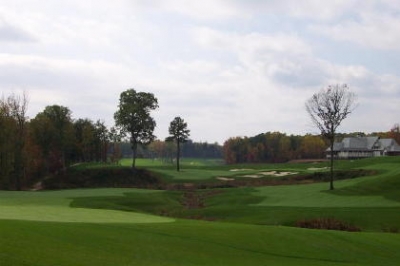 |
| The 9th Hole at Kinloch Golf Club. |
David Malone, Providence Golf Course's (which George completely redesigned) Director of Golf, described George's architectural talents in a slightly different way, claiming the designer is like 'Rain Man' when it comes to routing a golf course.
Truly, a high compliment.
I've had the chance to talk with George on several of his projects, where he's shared his enthusiasm for his work. See how it comes through in his words:
GTMA: I noticed you got your start with a West Coast golf design firm, yet you're based here in Virginia. How'd that come about?
George: I'm a native Richmonder. I'm an air force brat, but my Dad was raised here and my family went to school here at the University of Richmond. So I moved back here -- and when I got out of the military, I decided I didn't want to go to the west coast. So I just apprenticed for a west coast firm -- doing all their east coast stuff.
GTMA: I'm sure it's helped to get some work, being from the 'neighborhood.' You've been pretty successful in the relatively short time you've been on your own - starting with The Colonial in Williamsburg. How did that come about?
George: The Colonial was our first 'solo' project, and we're pretty proud of it. Golf Magazine called it one of the top 10 daily fees in the country that year, and so did The Golfer Magazine.
We were able to build it because of a special relationship we'd developed with Francis Fenderson (the Colonial's owner and developer). Francis was an early counselor if you will, and provided me with a lot of guidance. He helped me set up my corporation, and introduced me to the people I originally went to work for. And it turns out that he was there almost all the way through the process.
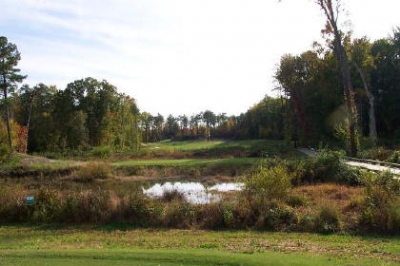 |
| The view from the tee at Providence Golf Course's 3rd Hole. |
Then, when I set up my corporation, I asked Francis to do the legal work, and he asked me out of curiosity, "What are you doing now?"
I said "Well, I've got this great piece of property, and the only problem with it, Francis, is that I don't have a developer." And he said, "Let me see it."
So I went over there and showed it to him. He said, "I think this is pretty good."
I said, "I think it's as good as it gets on 210 acres."
The rest was history. I signed over the purchase contract to Francis and we went to work on building it.
GTMA: You were taking a bit of chance there, since you technically hadn't even purchased the property yet, had you?
George: Correct. I'd signed a contract to buy the property from an estate. It wasn't even for sale when I found it. I also realized it was a tremendous piece of land for a golf course - at that time, there was a lot of desire to do a daily fee in Williamsburg -- so I made arrangements for the purchase.
But having just started my company, I had very little money. They said, "Well, Lester, every real estate contract in Virginia has to be accompanied by a deposit." So I said, "How about $50 bucks?"
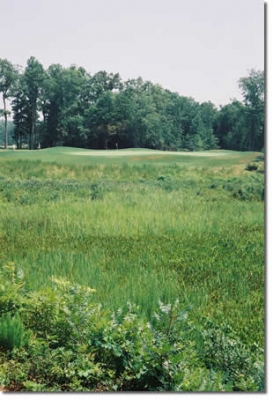 |
| Colonial Golf Course's 6th Hole. Photo Courtesy of Colonial Golf Course. |
They said, "Well, okay, we'll take it." So I gave 'em $50 -- and when Francis said he wanted to get involved in the project, I signed the contract over to him for the same sales price (substantially higher, as you'd imagine), and he signed the design contract. I didn't expect him to do that -- he stepped in and did it.
GTMA: Speaking of valuable pieces of property, you must've felt touched by God to be able to work on Kinloch. Having seen a few golf courses myself, I'd say the Kinloch site has to rank up there with the best I've ever seen. When you were working on the project, was it a goal to make it a highly ranked course in the United States and the World?
George: It's always our goal to do the best we can with the piece of property we're given. In that regard, I knew that Kinloch was a great piece of property, and I knew it would rank highly, at least in my mind's eye.
I also knew we were going to be given a sufficient budget to do it the way I wanted -- which was the amount of land, etc... Because of that, I was able to put in some alternate fairways and produce several different shot options, literally on every hole.
Because we moved very little dirt (180,000 yards total), the budget was still kept to an amazingly modest level, considering the finished product. We were able to turn around and covert what money we might've used in 'creating' golf holes into buying sod -- and we sodded the entire golf course, fairways and rough areas both.
GTMA: True. But at what point did you realize what you had there?
George: I knew by the quality of people involved, and by the quality of the site that it had a chance of being highly regarded. But you never set out by saying "This is going to be the #1 private golf course in the country, this year... the highest ranked golf course in the history of Virginia," or anything like that. It turns out that it debuted at #23 on the 100 greatest modern courses list. I never set out to do that. I set out to do the best I could with the site, and the rest is done for us.
GTMA: Every one of your courses that I've played has a very generous amount of room off the tee. Is that something that's important in your design philosophy?
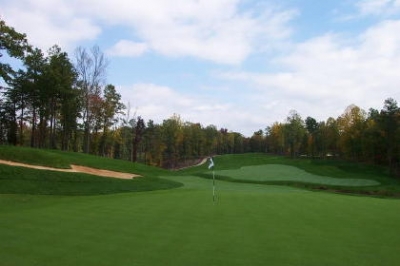 |
| Kinloch Golf Club's 6th Hole. |
George: Well, we always want to build strategic golf courses. If you play them more than once, you realize that there are portions of the fairways -- and even though you might be in them -- you might actually be much better off being in the other half of the fairway on a particular hole.
We want to create a golf course that's demanding off the tee if you're a precision-type player, but not as demanding if you're not a precision player. In other words, you can put it in the fairway and finish a hole, or you can pick your spots and have a much better angle for attacking the greens.
It may look like a wide-open driving golf course, but there's a lot of strategy involved if you become familiar with the layouts.
GTMA: How important is it to provide options on a course?
George: Extremely important. The last thing we want to do is create a golf course that's like a dart board game, where you basically just throw it up high and let it land.
We like to incorporate some areas where you can play it low to the ground if you choose. Or if you're a low-ball hitter, you'll have the option to run the ball up. Playing golf on or near the ground is a lost art on a lot of these courses, because they require you to fly it onto every green, then stop it quick.
Take the second hole at Kinloch, for example. If you play it down the left side off the tee (the more difficult option), you can literally hit a belt high eight-iron all the way to the back pin placement, with no obstruction, and the ball will roll, just like a putt.
On the other hand, if you choose the fat side of the fairway on that hole, you've got a much more difficult shot where you'll have to hit it high and land it soft. The hole's above you, there's a bunker to clear, and a wetland in front of that.
 |
| Providence Golf Course's 18th Hole. |
Those are all the kinds of things that we look for when we do design. They're not unique to our experience of design, but they're unique to each particular course, where we find a lot of opportunities like that. And every time we find one, we debate and discuss why it's important to have it that way.
GTMA: How do you think your early success will impact your career?
George: It's hard to say, but you certainly can't rest on your laurels. You've got to go out and try to make every project as good as your best work. I'd like to have some of the opportunities that my colleagues have had.
We're looking at some coastal/waterfront sites now that have a lot of promise. Having your past work being recognized brings you better sites in the future. So you rack it up to experience. I don't know if I'll ever have a project like Kinloch again, because it was a whole set of circumstances, not just working on a tremendous piece of property.
I will tell you this -- working with Vinny Giles on Kinloch was an absolute joy.
GTMA: He said working with you on the Kinloch project was the most fun he's ever had in golf, and that's saying a lot considering his background.
George: That's flattering, it really is.
I'll tell you -- when you're collaborating with someone on an artistic endeavor, which is not always a successful thing, you'll want that person to give you your freedom to do your artistic 'thing.' Vinny was absolutely as good as anyone I've ever worked with -- he's the best. Because the more he tried to say, "I don't know what I'm doing here, but here's what I think," the more I turned around and said "that's entirely architecturally correct, and here's why I think we ought to do it."
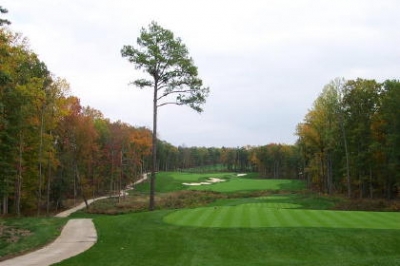 |
| Kinloch Golf Club's 2nd Hole. |
I don't think in 2 1/2 years out there that we ever spoke a single contentious word, and I'm as proud of that as anything. That meant we were looking out for him, and he was comfortable with it. And he added a lot. His knowledge of the game, and hitting different shots, and around the greens -- he really did have some specifically great ideas around which greens should be run-ups, which greens should have some severity in 'em...
And it just so happens, I agreed with every one of his analyses. We didn't have one thing where he said "Well, I'd like it like this," and I said "no, I don't want it like that, I want it like this." That just never happened.
GTMA: Another thing we've noticed about your work - is your prominent use of trees in your designs. It seems like every architect seems to have different thoughts on trees in the design -- some like 'em, others don't. You must be in the former group, right?
George: You know what, I'm really kind of a tree-lover type of guy, and if there are specimens that are out there, I like to preserve 'em as much as I can. I think that's pretty much true of most architects.
But I talked to Robert Trent Jones Sr. one time about that, and he said "Lester, never rely on a tree, because the minute you need it, it won't be there."
GTMA: Right. Dan Maples said exactly the same thing.
George: So, the minute you design a hole around one of 'em, you have a problem. We take extraordinary precautions around specimen trees that we believe are key to the routing.
At Kinloch, the trees were part of a heavily wooded, untouched forest. We tried to save as many of the specimens as we could, but even after several years since being cleared, you'll still lose some.
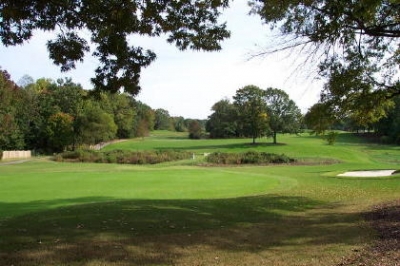 |
| The view from behind Providence Golf Course's 12th green. |
Providence was different, however. Those trees were all edge trees that were out in the middle of fairways twenty years ago. They were flourishing on their own -- they were hearty because they had thicker bark, and hadn't been in 'the woods,' so to speak.
I wouldn't necessarily say that I try to prominently feature trees, but I can say that on every golf course I've ever done, there're always a few specimen trees that I try to protect, because I think they add variety to the hole. I don't typically put them in the middle of fairways, but I like to set 'em off on the corners and go behind them with the clearing to try and make them stand out.
There's little doubting that Lester George's work stands out on the projects he's been involved with. Whether it's his 'Rain Man' acumen for routing golf holes on tight sites, or his contagious enthusiasm for the game of golf, he's left a mark that's considerable, and will only grow in the years to come.
Details:
For a full project list, as well as more information on Lester George, I suggest accessing his firm's website: www.georgegolfdesign.com.
| Related Links | Comments on this article? | |
|
Maryland National Golf Club Hollow Creek Golf Club Rocky Gap Resort PB Dye Golf Club in Ijamsville Whiskey Creek Golf Club |
E-mail Jeff Rendall, Editor: jrendall@golftheunitedstates.com |











